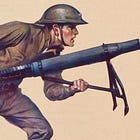In the spring of 1921, Captain LeRoy P. Hunt prepared the following problem for use at the Field Officers’ School at the Marine Barracks in Quantico, Virginia. While based on his experience of service in the days following the capture of Belleau Wood, it may contain elements that reflect his opinion of the way that things should have been done.
The exercise differs from conventional map problems of its day in asking students to engage it from the perspectives of three protagonists: the battalion commander, the company commander, and the leader of the patrol.
As I have not been able to find a complete copy of the map used for this exercise, I have edited the text to replace grid indications with references to landmarks, tactical symbols, and control measures.
In keeping with the customs and traditions of the Tactical Notebook, readers may use the comments section to offer their own solutions.
General Situation
The General Situation is that of the World War as of 26th June, ‘18.
The 4th Brigade US Marines, 2d Division A.E.F., has been holding the general line [marked in red on the map] since 26th June ‘18. The 1st Battalion, 5th Marines, is holding that portion of the line on the extreme left of the Brigade … with two companies in the front lines and two along the Battalion Reserve line.
The left front line company hold that portion of the line from [the left boundary of the Brigade] to the road fork …
The Germans are holding a line [marked in blue on the map].
Special Situation
Recent activity in the enemy’s line indicates that he is preparing for an offensive and the Observation Posts and Airplanes report the arrival of new units on the front opposite the 4th Brigade. Considerable movement of small groups has been observed around [the] barn [shown in gray, just south of the village of Torcy, on the map]
At 0900 AM, 29th June ‘18, Major A, commanding 1st Battalion, 5th Marines, receives orders from the Regiment, to make every effort that night to capture prisoners for identification.
Required
Major A’s Action and Orders.
Captain B’s Action and Orders. (Note: Captain B commands Company A, the left front line company of the Battalion, from which the patrol is sent.
Lieutenant Y’s Action and Orders. (Note: Lieutenant Y is the Lieutenant of Company A, detailed by Captain B as patrol leader.)
For Further Reading:










1. As Maj A: action is to either stand up the Bn's artillery or (if a 1918 US marine Bn doesn't have much of its own) beg/borrow/steal more from the division in order to carry out my orders. This is well into the war and we're worried the enemy might be about to hit us hard; now is not the time for a raid on so small a scale it can proceed without at least a whirlwind bombardment. Orders to Cpt B are to organise a trench raid in force: (what by this point is hopefully) standard procedure, identifying marks removed from all men's uniforms, everyone loaded to bursting with grenades (do we call them bombs in this war or is that only the British?), knives and wirecutters, time in contact with the enemy to be measured in seconds not minutes if at all possible. Target location is his call but should be determined as early as possible so the artillery can be prepared.
2. As Cpt B: action is to determine a suitable location, feed it back, firm up the artillery plan and scrounge up whatever's best from the mess tents for anyone who'll volunteer to go on the raid rather than having to be ordered. Orders to Lt Y are to get a platoon's worth of men together for a trench raid at that location in time with the cover the artillery will allow him. Depending on how gung-ho I'm feeling and how favourable the terrain (heh, as if) and weather are, may order that a smaller, secondary raid be launched by no more than a section on a different part of the line, immediately before the bombardment. You never know, might catch them napping.
3. As Lt Y: action is to get men together, fed and watered, and briefed on the plan. Specifics - can we crawl out into no-man's land beforehand or do we need to wait for the bombardment? One group or several? - dependent on the lie of the land, the weather, the amount of artillery support we can expect and our estimate of the enemy's disposition. Presumably he'll be awake, alert and in force wherever we go, so that'll be fun.
Have you read “Infantry in Battle” 1939 - Marshall was behind its publication. WW2 army went to war on it.